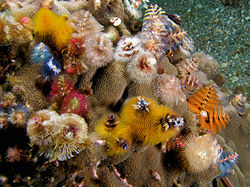- Spirobranchus giganteus
-
Spirobranchus giganteus 
Christmas Tree Worm (Spirobranchus giganteus) in Porites coral Conservation status Scientific classification Kingdom: Animalia Phylum: Annelida Class: Polychaeta Order: Canalipalpata Family: Serpulidae Genus: Spirobranchus Species: S. giganteus Binomial name Spirobranchus giganteus
Pallas, 1766Spirobranchus giganteus, commonly known as Christmas tree worms, are small, tube-building polychaete worms belonging to the family Serpulidae.
Contents
Anatomy and morphology
The worm is aptly named; Both its common and Latin names refer to the two, chromatically hued spiral structures that are most commonly what is seen of the worm by divers. In actuality, these multicolored spirals are merely the worm's highly derived respiratory structures.
S. giganteus is similar to most tube-building polychaetes. It has a tubular, segmented body lined with chaeta, small appendages that aids the worm with its mobility. As it does not move outside its tube, this worm does not have any specialized appendages for movement or swimming.
The worms's most distinct features are the two "crowns" that are shaped like Christmas-trees. These "crowns" are actually highly modified prostomial palps which are specialized mouth appendages of the worm. Each spiral is composed of feather-like tentacles called radioles, which are heavily ciliated which allows any prey that are trapped in them to be transported straight towards the worm's mouth. While they are primarily feeding structures, S. giganteus also uses its radioles for respiration. It is because of this that the structures are commonly called "gills".
One of the major differences between Christmas-tree worms and the closely related sabellida fan worms is that the latter do not have any specialized body structures to plug the holes of their tubes with when they withdraw into them. S. giganteus, like the other members of its family possess a modified radiole, usually called the operculum, that it uses to secure its hole when withdrawn into its tube.
As an annelid, S. giganteus possesses a complete digestive system. It has a well-developed closed circulatory system. Like other annelids, these worms possess well-developed nervous systems with a central brain and many supporting ganglia, including pedal ganglia, which are unique to the Polychaeta. Like other polychaetes, S. giganteus excrete with fully developed nephridia. When they reproduce, they simply shed their gametes straight into the water where the eggs (and spermatozoa) will become part of the zooplankton and can be carried by the currents.
Range and distribution
Christmas-tree worms are widely distributed throughout the world's tropical oceans. They have been known to occur from the Caribbean to the Indo-Pacific.[citation needed]
Ecology
Spirobranchus giganteus is commonly found embedded in entire heads of massive corals. Like members of its family, it can secrete a calcareous tube around its body. This tube serves as the worm's home and protection. S. giganteus usually bores a hole into an existing head of living coral before secreting its tube, thereby increasing its level of protection.
As sedentary inhabitants of coral reefs, Christmas tree worms feed primarily by filter feeding. They use their brightly colored radioles to filter microorganisms from the water, which are then deposited straight into the worm's digestive tract.
Few organisms are known to feed on tube-borne polychaetes and S. giganteus is no exception.
Importance to humans
While the worm itself has no commercial fishery importance, it is of interest to marine aquarists and divers everywhere. The variously colored worm crowns make extremely popular underwater photographic subjects for sport divers. Many aquarists that have miniature reef aquariums purposely include heads of coral that S. giganteus specimens inhabit.[citation needed]
Conservation status
As the species is widespread and relatively common, there are no conservation efforts focusing on this species (or Polychaetes in general).
Etymology and taxonomy
Spirobranchus essentially translates to "spiral gills", referring to the worm's unique crown.
There are two subspecies recognized by the ITIS, S. gigantea corniculatus[1] and S. gigantea gigantea[2].
References
- ^ "Spirobranchus gigantea corniculatus". Integrated Taxonomic Information System. http://www.itis.gov/servlet/SingleRpt/SingleRpt?search_topic=TSN&search_value=68304. Retrieved 24 January 2007.
- ^ "Spirobranchus gigantea gigantea". Integrated Taxonomic Information System. http://www.itis.gov/servlet/SingleRpt/SingleRpt?search_topic=TSN&search_value=68305. Retrieved 24 January 2007.
Gallery
-
Christmas Tree Worm from the South China Sea.
-
Christmas Tree Worm from the South China Sea.
-
Christmas Tree Worm from Papua New Guinea.
-
Christmas tree worms (Spirobranchus giganteus) from East Timor.
-
Spirobranchus giganteus embedded in a brain coral in a reef in Bonaire.
Categories:- IUCN Red List least concern species
- Fauna of the Philippines
- Serpulidae
- Animals described in 1766
Wikimedia Foundation. 2010.







